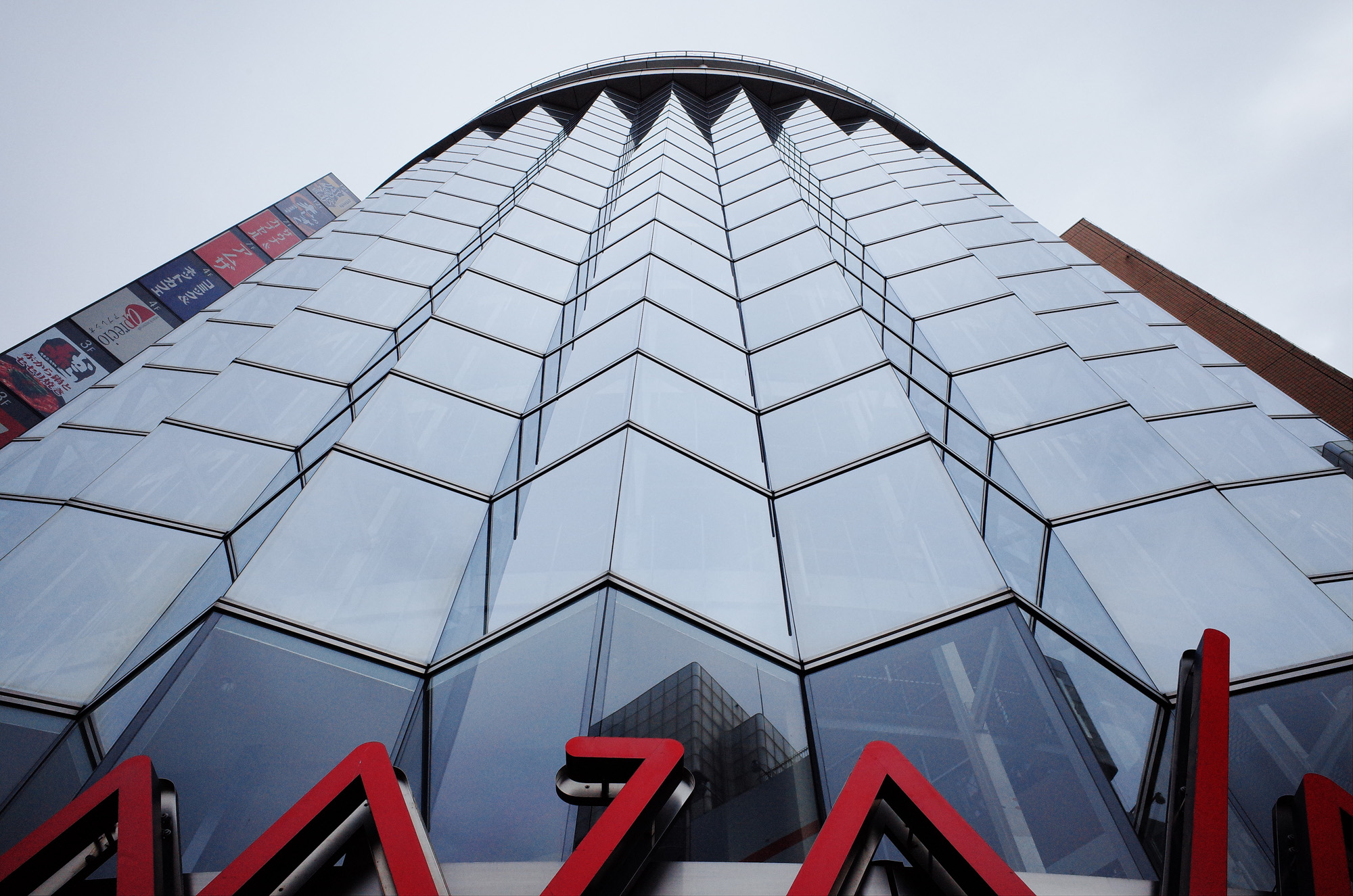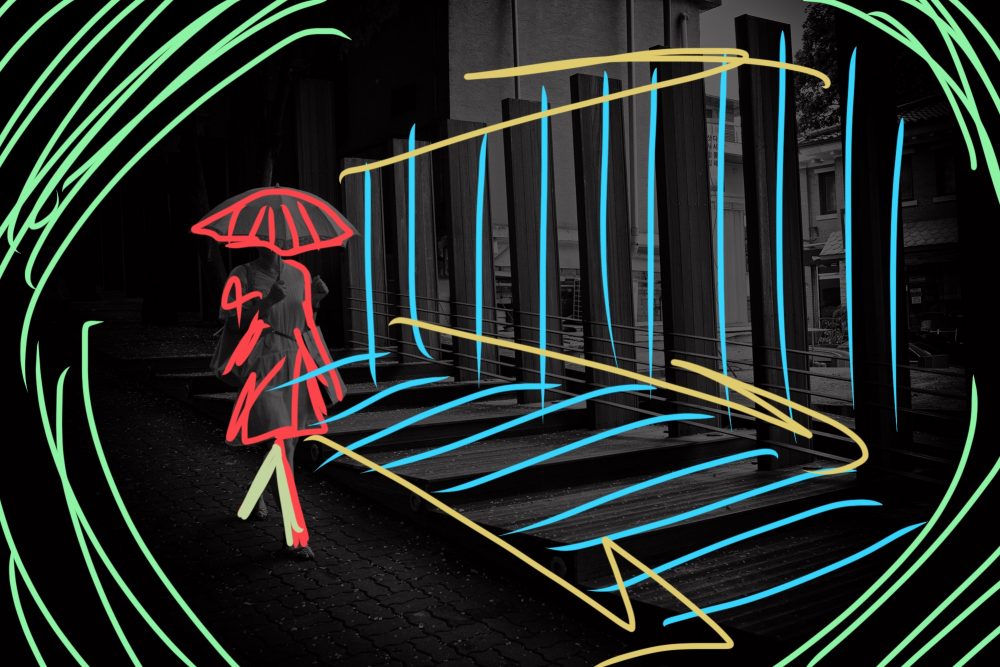Dear friend,
A very simple photography composition tip: Look up!
Practical ideas/suggestions:
1. Use a wide-angle lens

Use a wide-angle lens (24mm, 28mm, 35mm) and look up, when photographing architecture or even the sky!

If you’re shooting a building, get very close to the side of the building, and look straight up!

Tip: Do more back-bends in yoga, to have a stronger back to look up!
The benefit of using a wide-angle lens in photography when looking up: you get more of the sky, or the architecture you shoot is more dynamic!

Or you can even use a medium-format TLR or Rolleiflex/Hasselblad camera with the waist-finder, and look up!
You can also do this digitally, with a flip-up/tilting LCD screen.
2. Shoot the edge of a building

When photographing architecture or buildings, try to get the edge in the photo. Visually this will better emphasize the diagonal/triangle compositions in the building.

Or another idea: Photograph the CURVE of a building:

3. Take a selfie with your phone on the ground

Fun experiment: put your camera phone in selfie mode, and put on the camera timer. Put your camera on the floor, and have a bunch of friends huddling around the camera, and shoot looking up!

4. Crouch down low, and photograph your subject against the sky/buildings

When shooting street photography, crouch down very low, and shoot your subject against the sky, to make them look ‘larger than life’ (superman effect), and making them look more powerful! Also by photographing your subject against the sky, you will better simplify your photo.








5. Diagonal composition

When you’re shooting up, photographing buildings or light poles/power lines, tilt your camera and make a diagonal composition, to make your composition more dynamic!
6. Look STRAIGHT UP!

Get in the middle of the road or some spot, and look straight up! Try to straighten (horizontal an
 d vertical) lines of whatever you are photographing. This will give you a novel perspective.
d vertical) lines of whatever you are photographing. This will give you a novel perspective.
7. Photograph the corner of your room

Look up and photograph the corner of your room

8. Get close to the side of the building, and shoot straight up!

9. Shoot the sky

Such a simple concept: but shoot the sky more often! I love to photograph clouds, because they are beautiful. Clouds put a smile on my face, and give me more hope and optimism in life! And they make me remember when I was a kid, when I used to lay on the grass, look up, and daydream and just imagine what the clouds looked like.
10. Shoot up looking at mirrors/reflections

A selfie I shot inside the BAPE store in Shibuya, Tokyo, where the whole building is full of reflections and windows.
When you’re in a place with windows, reflections or a lot of glass, try to shoot looking up, and bonus points if you get a selfie of yourself in the frame!
11. Put your camera really low to the bottom of the floor, and shoot looking up!

An example composition, with the ‘dutch angle’ (tilted/diagonal composition), with my RICOH GR II (28mm lens) on the floor, and looking up for a much more epic composition!
12. Photograph planes/helicopters

Pay attention to what is happening around you — try to shoot a plane/helicopter as it is crossing over you!
13. Tilt your camera

Composition is more fun and interesting when the horizon isn’t level. Purposefully tilt your camera to create the ‘dutch angle’ composition:


14. Shoot looking up inside stores

Go inside a grocery store, and get very close to whatever you’re photographing, and look straight up!
15. Shoot through colored textures

Simple tip: When you’re shooting, look for translucent textures or surfaces, and look up, and shoot through them!
16. Get on top of a roof and shoot up!
Get on top of a roof, and shoot up! This will give you a better unobstructed view of the sky or whatever you’re trying to photograph:



HOW TO SEE: Visual Guide to Composition, Color, & Editing in Photography

HOW TO SEE is your personal visual acuity manual to learn to “SEE” composition, color, and “read” (evaluate) the elements of a good photograph..
Composition 101

Master composition for yourself:
Photography Composition Tips

- 5 Simple Street Photography Composition Tips
- Depth Perception
- Golden Angle Composition in Street Photography
- Photographer as an “Arranging Artist”
- Dynamic Off-Center Street Photography Compositions
- 5 Essential Composition Tips in Photography
Color Theory

- Red and Green Composition Color Theory For Photographers
- The Ultimate Beginner’s Guide to Color Photography
- Opponent Process Color Theory For Photographers
- Color Theory For Photographers
- Color Manual
- How to Shoot Color Street Photography
Learn From the Masters of Composition

- 10 Lessons Matisse Can Teach You About Art and Life
- Henri Cartier-Bresson Composition
- 10 Timeless Lessons Edward Weston Can Teach You About Photography
- 10 Inspirational Sergio Larrain Compositions
- 5 Henri Cartier-Bresson Photography Composition Lessons
Dynamic Photography Composition 101

- Introduction to Dynamic Photography Composition
- How to Visually Analyze Your Photography Compositions
- Dynamic Tension: Opponent Based Theory For Photography
- Opponent Process Color Theory For Photographers
- Dynamic Photography Composition 101: Figure to Ground
Painting Compositions

Dynamic Photography Composition Tips

- 7 Simple Photography Composition Tips
- How to Make Aggressive Photography Compositions
- 10 Dynamic Photography Composition Tips
- How to Make More Dynamic Picture Compositions
- Unorthodox Photography Composition Techniques
- Deconstructed: Saigon Eric Kim Photos
Composition Theory

Take your composition to the next level:
- Gestalt Theory
- Juxtaposition
- Center Eye
- Low-Angle
- Dutch Angle
- Deep Depth
- Spacing
- Silhouette
- Leading Lines
- Figure to Ground
- Fibonacci Spiral
- Cropping
- Emotion
- Composition by Eric Kim
Street Photography Composition 101

For distilled lessons on composition, read the free ebook: “The Street Photography Composition Manual.”
Further articles to improve your compositions in photography:
- Composition Lesson #1: Triangles
- Composition Lesson #2: Figure-to-ground
- Composition Lesson #3: Diagonals
- Composition Lesson #4: Leading Lines
- Composition Lesson #5: Depth
- Composition Lesson #6: Framing
- Composition Lesson #7: Perspective
- Composition Lesson #8: Curves
- Composition Lesson #9: Self-Portraits
- Composition Lesson #10: Urban Landscapes
- Composition Lesson #11: “Spot the not”
- Composition Lesson #12: Color Theory
- Composition Lesson #13: Multiple-Subjects
- Composition Lesson #14: Square Format
Composition Theory

Learn compositional theory:
- Why is Composition Important?
- Don’t Think About Composition When You’re Shooting Street Photography
- How to Use Negative Space
- Street Photography Composition 101
- The Theory of Composition in Street Photography: 7 Lessons from Henri Cartier-Bresson
Compositional lessons from the masters of art
Composition lectures
Composition pictures/grids


Golden Diagonal Composition













